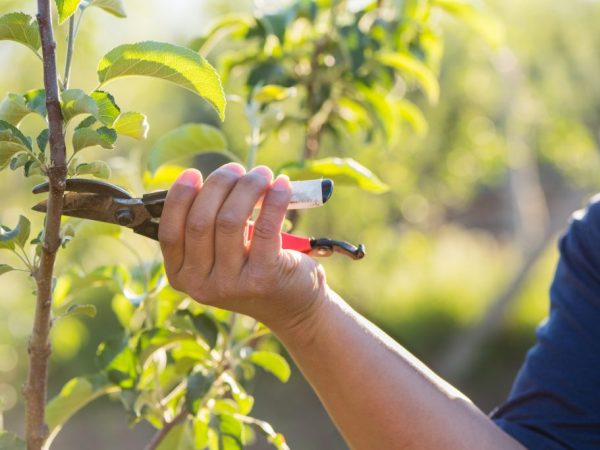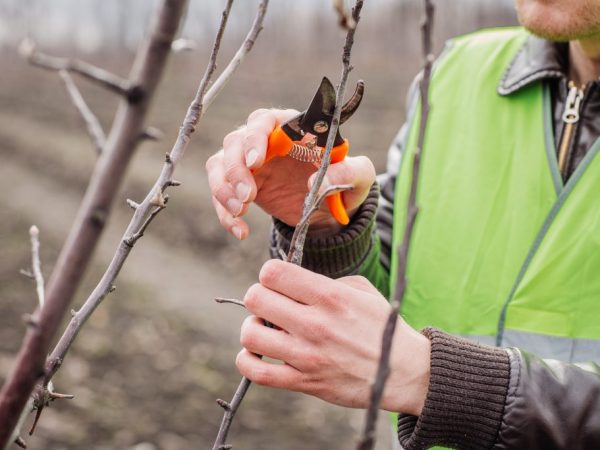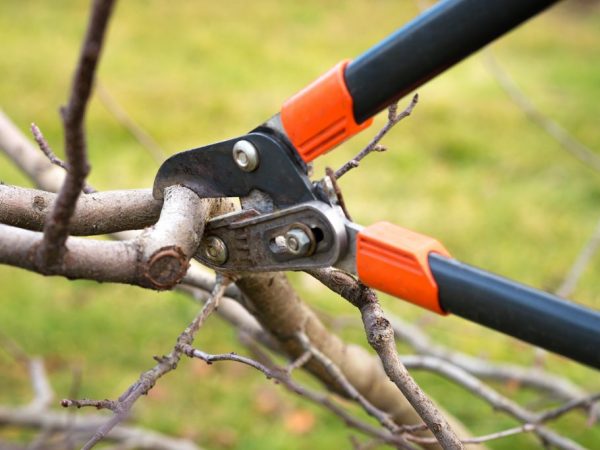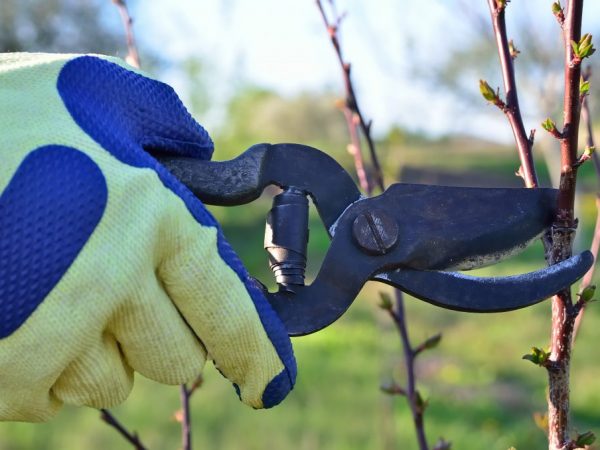Rules for pruning apple trees in spring
To obtain large yields and the formation of the correct crown, pruning of apple trees is carried out in the spring. During this period, trees tolerate this procedure better. When pruning, it is important for novice gardeners to take into account the age of the tree and the peculiarities of its development, then the apple tree will grow healthy and delight with juicy fruits.

Rules for pruning apple trees in spring
Timing
Correct pruning of apple trees in spring is carried out in a clearly defined period - before the start of the growing season. In one- and two-year-old trees - in the process of planting. The most suitable period will be the moment before the opening of the first buds, before the sap flow begins.
The air temperature must be at least -10 ° C. After the winter cold, some of the branches freeze out, the buds are damaged, so you should start removing them. Pruning old branches growing inside the crown is necessary in order to direct all nutrients to the fertile parts of the crop and create conditions for a bountiful harvest.
With proper pruning, strong skeletal branches are left that will not break under the load of a ripening crop. After these manipulations, the crown will not be so thickened and the tree will receive more sunlight, which means that the immunity of the apple tree will be stronger and it will quickly renew the protective layer in the places of the cut.
Tools
Spring pruning is carried out using professional tools that will provide the most gentle cut for the tree and make the process comfortable for the gardener. An important point that beginners should pay attention to: the components should not be rusty and clean.
Before starting work, you should treat the tools with an antiseptic (for example, alcohol). Disinfection is carried out to avoid infection with fungal infections when moving to each subsequent tree.
Secateurs

Choosing a convenient tool
The main tool in a fruit orchard is a pruner. It helps to provide maintenance of the garden, and the comfort of the gardener depends on its quality during work. There are two types of this device:
- with an anvil - this is a more convenient version of the tool, the blade of which works like an ax and cuts off strong, dried branches;
- bypass - works like a scissor and is suitable for removing thin shoots and trimming the trunk of annual apple trees. In this case, the supporting (lower and concave) blade should be at the bottom, and the working blade should be on the side of the main branch.
Choose pruning shears with blades made from hardened or high carbon steel with chrome plating. To keep the hand from getting tired, the tool is equipped with a ratchet mechanism and a belt-type spring with return. Convenience is provided by a polyimide or fiberglass handle.
Garden saw
The saw helps to remove branches that are too large for the pruner to remove.It is important to remember that a "hacksaw for wood" is designed to work with "dead" wood, and it will inflict severe injuries on living tissues, which will complicate the recovery process.
The saw, which is designed for cutting branches, has a slight bend for practicality and tapers towards the end. It easily works in two directions, without clogging up the sawdust obtained in the process.
Knife
A garden knife made of quality material will help get rid of various irregularities and burrs, making the cut smoother.
Lopper
A bar lopper can be used for taller apple trees. With its help, it is possible to eliminate the most difficult to reach branches. The principle of operation of the tool is the same as that of the pruner, with one difference - the telescopic handles are long and must be held with both hands.
Pruning for the age of the tree

Pruning should be appropriate for the age of the tree
Depending on the age of the apple tree, the pruning procedure differs.
3 year old apple tree
A three-year-old apple tree cannot yet be called an adult. Its crown is just acquiring its shape. Correct pruning of 3-year-old apple trees in spring is carried out according to the subordination scheme - the higher the tier, the shorter the branch. This will ensure an even distribution of sunlight.
In addition to giving shape to new developing skeletal shoots, extra branches that do not grow according to the scheme are removed from a three-year-old. The branches of the 1st level are covered with the 2nd level. As necessary and when tops appear, they are removed.
The formation of the 2nd level is carried out in the interval of 0.5-0.7 m from the 1st in such order that the upper branches are in the gaps of the lower one. Branches of further orders are shortened more (the conductor is 15-20 cm above the tier of the 3rd level, and the branches are shorter than those below).
The shape of the apple tree should be like an isosceles triangle, the base of which is parallel to the ground. The length of the branches of the 1st tier, as a rule, is equalized, i.e. pruning of a 3-year-old apple tree in spring is carried out in one length.
If the level is not the same, the growth point that is located above develops rapidly. This scheme can be used to stimulate or inhibit the growth of individual overgrown branches in the tier.
On a dwarf three-year-old, the shoots should be cut in the same order as in the 2nd year.
Leave on the tree:
- ringlets;
- mixed and bouquet twigs;
- fruit twigs;
- rings.
Crown pruning begins in early spring, the central guide is removed and the old lateral shoots of the last year are shortened to 20 cm.
In addition, you can change the direction of growth of branches by pruning, filling the resulting voids, and pulling young branches with spacers to change the angle of their growth.
2 year old apple tree
When pruning and creating a crown of two-year crops from the upper bud, which is 4-5 higher than the rest, a strong young shoot is grown, which will be a continuation of the main one. In order for the stem to be created to be straight, a procedure such as tying is allowed.
Young shoots growing parallel to its direction must be removed or folded back and secured so as not to create "competitors". Shoots at an angle of 45 ° or less must be removed or pulled back with props.
In the crown of an adult tree there should be several main guides, for which almost all the lateral shoots are left for a two-year-old seedling, but they are pruned so that the lower ones are longer than the upper ones. Extra and overgrown ones are removed when pruning in the third year.
If these conditions are met, the growing tree will have a rounded, spreading crown, which is sufficiently illuminated and does not shade the developing fruits, as well as a strong, powerful trunk.
1 year old apple tree
First, examine the sample. Too powerful, actively branching annual specimen grew on fertilizers or "lived" in the southern edges. Winter hardiness of such trees will be problematic in central Russia.
A typical annual seedling has only a few branches.Pruning of young apple trees in the spring is necessary first of all to equalize the roots "disturbed" during extraction from the ground with the size of the developing top.
To form a tree with a low stem, the central leader shoot is strongly pruned at the level of 3-4 branches with a slope to one of the processes, leaving not a piece of the trunk. The height of the trunk is about 1 m. The existing small shoots on the trunk, below the level of the lower tier, are removed.
The vertically directed shoots are cut to the bud growing outward, horizontal ones - to the upward one, and the remaining ones growing on the trunk should diverge symmetrically in different directions.
A dwarf one-year-old is recommended to be pruned, like a regular crop. The permissible length of the seedling is 0.5 m. The cut is made on the kidney opposite to the inoculation. After the initial pruning during the growing season, 5 powerful shoots will form on the tree, the upper one will be located vertically. You do not need to touch the dwarf apple tree during the summer.
Care and processing of cut points

Slices must be processed
After pruning apple trees in the spring, the trees need care. In one-year and two-year-old seedlings, the need for supervision and prevention is more pronounced than in adults who have adapted to growing conditions.
After the procedure for removing undesirable components of the crown, the sections formed on the apple trees are cleaned and treated with a special preparation. Its task is to protect the wound from fungal, bacterial infections and insect pests.
Improperly carried out restoration measures will negatively affect the immunity of the tree and its further yield.
The main rule is to prohibit the simultaneous pruning and subsequent smearing of the sections with drugs. Wounds need to be treated with fungicides or other specially prepared preparations, they need to be allowed to dry out, so they wait a couple of days in the spring, and a week in the fall.
Primary disinfection is carried out with such solutions:
- 3% Bordeaux liquid (dissolve 30 g of lime in 0.5 l of warm water, 30 g of vitriol - in 0.5 l of water, then very carefully pour, gently stirring, vitriol into a white solution);
- iron sulfate (30 g per 1 liter of water);
- potassium permanganate (pale pink);
- vitriol (50 g per 1 liter of warm water).
If the size of the injured area after the spring pruning of the apple tree is more than 3 cm, medical procedures are carried out:
- with a garden knife, bring the surface to a smooth state;
- a brush dipped in an antiseptic solution is carried over the wound - depending on the ambient temperature, the drying time ranges from 3 days to a week;
- damaged areas, without affecting healthy areas, are lubricated with a special preparation.
Means for sealing a dried saw cut:
- water-based paint;
- a talker made of mullein and clay;
- garden pitch;
- cement (for large surfaces);
- balm - artificial bark.
After the pruning of old branches has been carried out, the shoots may dry out. This is due to a violation of the movement of the juice. The tree in that place ceases to receive nutrition, and excessive evaporation of moisture also occurs.
A fresh cut may begin to crack. In places where the surface of the bark is disturbed, a hollow may form.
After pruning apple trees in the spring, beginners and seasoned gardeners will benefit from recipes for "healing" remedies that have been successfully used by leading gardeners for many years:
- paraffin, rosin, drying oil are mixed in a ratio of 10: 2: 0.5 to obtain a garden varnish, sifted and crushed ash can be added to enhance its effect;
- clay and mullein in a ratio of 2: 1 are thoroughly mixed with the introduction of straw and diluted with water to the consistency of thick sour cream;
- cement slurry is made from cement and sand (1: 3) with the introduction of water and drying oil into the mixture.
When applying the paint, it should be remembered that after a month its protective effect is neutralized by wind and sunlight, so the treatment must be repeated.
Frequent mistakes
It is very difficult, and in some cases impossible, to correct the errors made during the pruning of apple trees in spring.
Common mistakes gardeners make with this procedure include:
- the diameter of the crown decreases due to the removal of not competing, but the main shoot in terms of strength;
- the volume of the crown increases, which is associated with insufficient pruning and thinning, as a result of which the development of fruit branches slows down;
- drops of juice on the cut appear at the wrong time, when the vegetation process has already begun. The place is treated with a greasy chatterbox. If this does not help, clean it, wrap it with a bandage and re-lubricate it on top;
- the rot that manifests itself indicates a tinder fungus. To save the tree, remove the affected part, examining the rest. If the core is light, then the apple tree can still be saved, but in a short time. If the rot has spread to the base, the tree is removed and burned;
- a blackened saw cut speaks of cancer or cytosporosis. It is necessary to remove all infected parts of the seedling as soon as possible. Processing depends on the season. If the buds have already blossomed, then you can spray with 1% Bordeaux liquid, if not - 3% (a description of the preparation of the drug can be found in the instructions).

